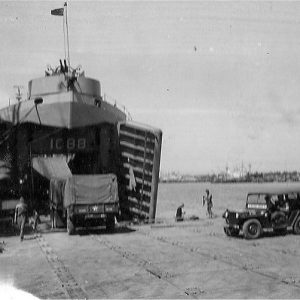calsfoundation@cals.org
USS Pulaski County (LST-1088)
The USS Pulaski County (LST-1088) was a tank landing ship that saw service in World War II and the Vietnam War. It was designated the USS Pulaski County on July 1, 1955, in honor of counties in seven U.S. states, including Arkansas.
LST-1088 was one of a class of vessels—called Landing Ship, Tank—created to carry tanks, wheeled and tracked vehicles, artillery, construction equipment, and supplies during military operations along coastal areas. Called “Large Slow Targets” by their crews, they were designed as shallow-draft vessels; when carrying a 500-ton load, LST-1088 drew only three feet eleven inches forward and nine feet ten inches aft. They carried pontoons amidships that could be used to create causeways when they had to debark their cargos from deeper water, but they were capable of dropping their forward ramps directly onto a beach.
The vessel’s keel was laid down on December 16, 1944, by the American Bridge Company of Ambridge, Pennsylvania, and christened and launched on February 11, 1945. LST-1088 weighed 1,625 tons, measured 328 feet long and fifty feet wide, and could reach speeds of 12.0 knots. It carried a crew of seven officers and 104 men and could transport sixteen officers and 147 soldiers. LST-1088 was armed with two twin 40mm guns, four single 40mm guns, and twelve single 20mm guns. It was commissioned at Algiers, Louisiana, on March 27, 1945, under the command of Lieutenant Sheldon Potter III.
LST-1088 had its shakedown cruise (a test of the ship’s performance) off the Florida coast before departing on May 6, 1945, for the Pacific. The vessel carried occupation troops to Wakayama, Japan, on October 28 after making stops at Pearl Harbor, Eniwetok, Guam, Saipan, and Manila. LST-1088 delivered troops and cargo to Okinawa, Sasebo, Saipan, and Pearl Harbor before sailing to San Francisco, California, arriving on January 19, 1946. It was sent to Portland, Oregon, in March; decommissioned on August 29, 1946; and placed in the Columbia River Group of the Pacific Reserve Fleet.
The vessel was designated the USS Pulaski County on July 1, 1955, and in 1961 was moved to a Reserve Group at Bremerton, Washington. The Pulaski County was recommissioned on May 21, 1963, and sent to join Reserve LST Squadron 2 at Little River, Virginia. In late February 1965, it was assigned to support a Gemini spaceflight, and from May 22 to August 25 the vessel supported U.S. personnel in the Dominican Republic. In early 1966, the Pulaski County was sent to support American operations in Vietnam, performing those duties until being transferred to the Military Sea Transportation Service in July 1967 to be run by a civilian crew. The vessel was struck from the navy list on November 1, 1973, and on January 1, 1975, was sold by the Defense Reutilization and Marketing Service for scrapping.
For additional information:
“LST 1088 Pulaski County.” DANFS Online: Amphibious Ships. https://www.hazegray.org/danfs/amphib/ (accessed June 13, 2018).
Rottman, Gordon L. Landing Ship, Tank (LST) 1942–2002. Oxford, UK: Osprey Publishing Co., 2005.
“USS Pulaski County (LST 1088).” NavSource Online. http://www.navsource.org/archives/10/16/161088.htm (accessed June 13, 2018).
Mark K. Christ
Little Rock, Arkansas
 Military
Military World War II through the Faubus Era, 1941 through 1967
World War II through the Faubus Era, 1941 through 1967 USS Pulaski County
USS Pulaski County  USS Pulaski County
USS Pulaski County 




I served on the USS Pulaski County from 1966 until it was decommissioned in Pusan, Korea, in mid-1967. We visited such ports as Inchon, Naha, Okinawa, Hong Kong, and numerous ports in South Vietnam. Our mission was to haul cargo upriver in the Mekong Delta. We hauled munitions, c rations, concrete for the airbase at Cantho, and troops we loaded in Saigon. We also hauled beer from Korea and barbed wire. We spent Christmas in DaNang in 1966, and we weren’t allowed to go ashore. It was a lot of work keeping her going, but we managed and those were times I’ll remember for life. It was an honor to have served aboard her.